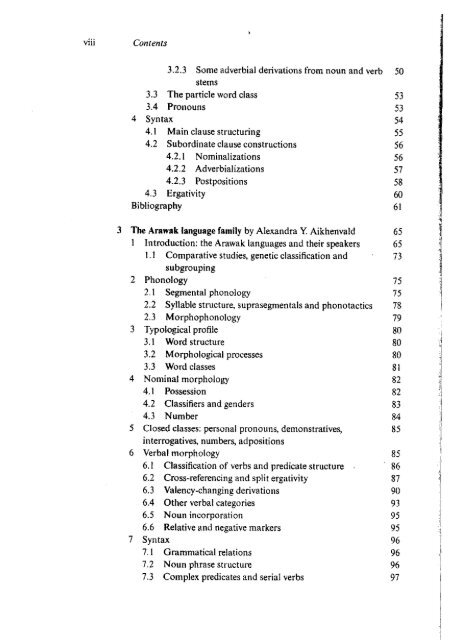The Amazonian Languages
by R.M.W. Dixon and Alexandra Y. Aikhenvald
by R.M.W. Dixon and Alexandra Y. Aikhenvald
You also want an ePaper? Increase the reach of your titles
YUMPU automatically turns print PDFs into web optimized ePapers that Google loves.
viii Coments Contents ix<br />
3.2.3 Some adverbial derivations from noun and verb 50 7.4 Constituent order 98<br />
stems 7.5 Non-verbal clauses<br />
98<br />
3.3 <strong>The</strong> particle word c1ass 53 7.6 Complex sentences: relative c1auses, complement 99<br />
3.4 Pronouns 53 c1auses, coordination, pivot and switch-reference<br />
4 Syntax 54 <br />
7.7 Grammatical mean s used for marking díscourse JOI<br />
4.1 Main clause structuring 55 functions<br />
4.2 Subordinate c1ause constructions 56 Bibliography 102<br />
4.2.1 Nominalizations 56 <br />
4.2.2 Adverbializations 57 4 Tupí by Aryon D. Rodrigues 107<br />
4.2.3 Postpositions 58 1 Introductíon 107<br />
4.3 Ergativity 60 2 Pbonology 110<br />
Bibliogmphy 61 2.1 Vowels<br />
110<br />
2.2 Consonants 112 <br />
3 <strong>The</strong> Arawak language family by Alexandra Y. Aikbenvald 65 <br />
2.3 Tone 114 <br />
I<br />
1 Introduction: the Arawak languages and their speakers 65 3 Grammatical overview 114 <br />
1.1 Comparative studies, genetic c1assification and 73 4 Nouns 115 <br />
subgrouping 5 Pronouns 117 <br />
2 Pbonology 75 6 Verbs 118 <br />
2.1 Segmental phonology 75<br />
11 7 Demonstratives 120 <br />
2.2 Syllable structure, suprasegmentals and phonotactics 78 I<br />
8 Questions 120<br />
2.3 Morphophonology 79 9 Subordinate clauses 121<br />
3 Typological profile 80 10 Pivots<br />
121<br />
3.1 Word structure 80 Bibliogfaphy 122<br />
3.2 Morphological processes 80 <br />
3.3 Word c1asses 81 5 Tupl-Guaraní by Cheryl Jensen 125<br />
4 Nominal morphology 82 1 Introduction<br />
125<br />
4.1 Possession 82 2 Identification of Tupí-Guaraní languages 128<br />
4.2 Classífiers and genders 83 2.1 Distinguisbing characteristícs of Tupí-Guaraní 128<br />
4.3 Number<br />
84 <br />
languages<br />
5 Closed classes: personal pronouns, demonstratives, 85 <br />
2.2 Subgroups within Tupí-Guaraní 129<br />
interrogatives, numbers, adpositions 3 Proto-Tupí-Guaraní pbonology 133<br />
6 Verbalmorphology 85 3.1 Proto-Tupí-Guaraní phonemes<br />
133<br />
6.1 Classification of verbs and predicate structure 86 3.2 Proto-Tupí-Guaraní allomorphs 134<br />
6.2 Cross-referencing and split ergativity 87 3.3 Possible Tupí-Guaraní morphopbonemic phenomena 135<br />
6.3 Valency-changing derivations 90 3.3.1 Replacement by nasal consonants 135<br />
6.4 Other verbal categories 93 3.3.2 Strategies for the loss of consonant clusters 136<br />
6.5 Noun incorporatíon 95 formed at morpbeme juncture<br />
6.6 Relative and negative markers 95 4 Phonological changes witbin Tupí-Guaraní 137<br />
7 Syntax 96 4.1 Weakening of "'tJand "'ts<br />
137<br />
7.1 Grammatical relations 96 4.2 Palatalization 138<br />
7.2 Noun phrase structure 96 4.3 Labializatíon 140<br />
7.3 Comp1ex predica tes and serial verbs 97 4.4 Merger of *pwith *w 141


















